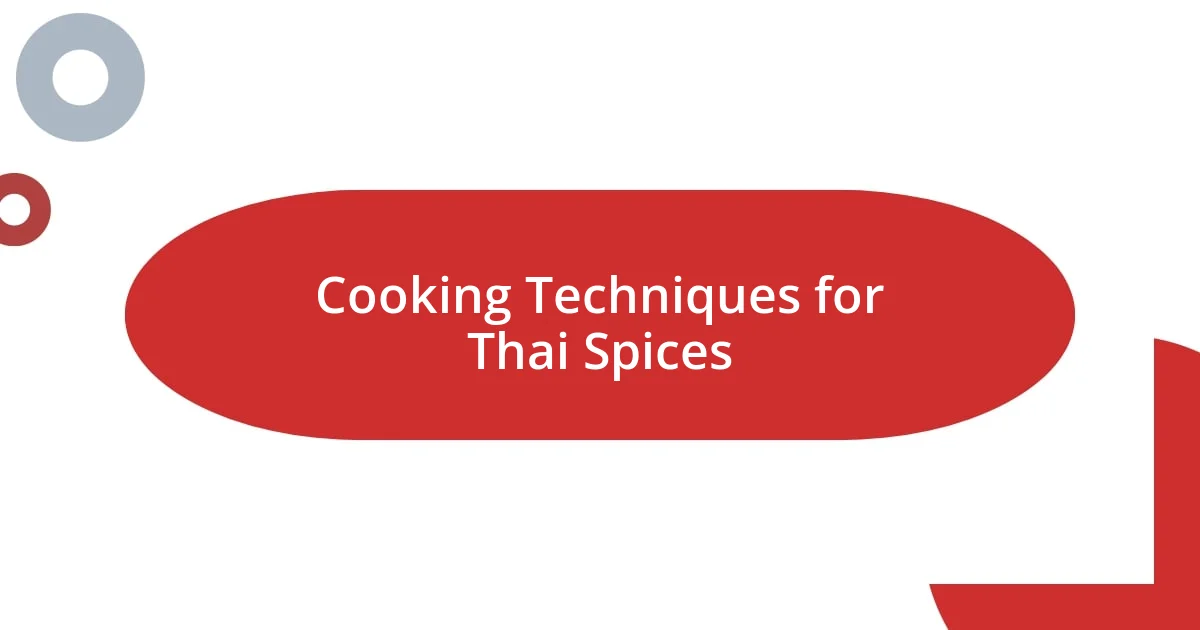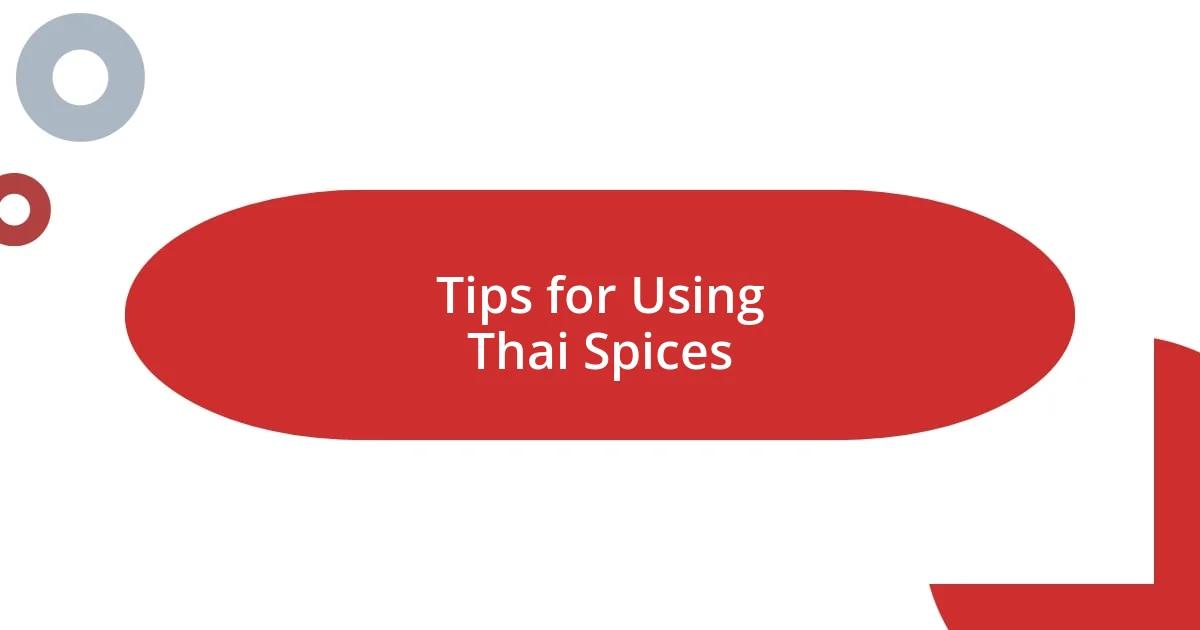Key takeaways:
- Thai spices create a unique balance of flavors in dishes, incorporating elements like sweetness, sourness, saltiness, bitterness, and spiciness for a harmonious culinary experience.
- Essential Thai spices include bird’s eye chili, lemongrass, and galangal, each contributing distinct characteristics that elevate traditional recipes.
- Mastering cooking techniques such as dry roasting spices and tasting throughout the cooking process enhances flavor depth and ensures balanced dishes.

Introduction to Thai Spices
Thai spices are a captivating blend of flavors, textures, and aromas that evoke a sense of adventure in cooking. I remember the first time I opened a package of Thai basil; the fragrant notes instantly transported me to bustling street markets in Thailand, where the air is thick with exotic scents. Have you ever experienced the excitement of discovering spices that are so vibrant they can truly transform a dish?
What makes Thai spices stand out is their unique ability to create harmony in both sweet and savory dishes. Each spice, from the heat of bird’s eye chili to the fragrant lemongrass, serves a specific purpose, contributing to a balance that is quintessential to Thai cuisine. I found it fascinating how a simple addition of galangal can lend warmth and depth to a recipe, almost as if it acts as a bridge between different flavors in a dish.
Exploring Thai spices is like uncovering the secrets of a rich cultural heritage. I vividly recall a cooking class where I ground fresh herbs and spices into a paste. The tactile experience of crafting my own curry made me feel connected not only to the ingredients but also to the traditions they represent. Isn’t it intriguing to think how each sprinkle of spice carries stories from generations past?

Essential Thai Spices to Know
When diving into the world of Thai spices, there are a few essentials that any home cook should become familiar with. For instance, the vibrant and fiery bird’s eye chili is a staple that packs a punch. I remember adding just one finely chopped chili to my first homemade curry, and it sent waves of heat dancing across my palate. It’s surprising how a tiny ingredient can create such a bold impact, isn’t it?
Lemongrass is another vital component that embodies the essence of Thai cuisine. Its citrusy notes add brightness and freshness to dishes. I still recall the smell of freshly minced lemongrass wafting through my kitchen as I prepared a fragrant soup. It immediately transports me to a sun-soaked afternoon in Thailand, where every dish feels like a celebration of flavors.
To round it off, galangal, often confused with ginger, brings an earthy robustness to many Thai recipes. I once made a paste featuring galangal, and the depth it added to my green curry was remarkable. It’s one of those spices that remind you how a single ingredient can elevate a dish from good to unforgettable.
| Spice | Flavor Profile |
|---|---|
| Bird’s Eye Chili | Fiery and pungent |
| Lemongrass | Citrusy and fresh |
| Galangal | Earthy and warm |

Unique Flavors in Thai Cuisine
The combination of flavors in Thai cuisine is truly unlike any other. The interplay of sweet, sour, salty, and spicy creates a symphony that dances on the tongue. I recall sitting down for a traditional Thai meal and being completely captivated by the explosion of flavors in a single bite. Each ingredient, from the subtle sweetness of palm sugar to the zing of lime juice, adds its own unique voice to the dish, making for an unforgettable experience.
Here are a few standout flavors you’ll find in Thai cuisine:
- Sweetness: Often from palm sugar, balancing heat and acidity.
- Sourness: A common element from lime juice or tamarind, refreshing and bright.
- Saltiness: Derived from fish sauce, adding depth and umami.
- Bitterness: Present in certain herbs, providing contrast to the sweet and spicy elements.
- Spiciness: The kick from various chilis, igniting the palate with vibrant heat.
Each element is thoughtfully integrated, and I’ve found that even one unfamiliar component can change the entire dish. I once prepared a red curry and, not knowing the pivotal role of kaffir lime leaves, I was astounded by how much more aromatic and complex it turned out once I added them later. It’s moments like that that make cooking with Thai spices an endless adventure!

Cooking Techniques for Thai Spices
When it comes to cooking with Thai spices, mastering certain techniques can really make a difference in flavor. One method I absolutely love is to dry roast spices like coriander and cumin seeds before using them. It sounds simple, but the aroma that fills the kitchen is unbelievably intoxicating. I still remember the first time I tried this – the spices transformed into a deeper, more aromatic version of themselves, elevating my dish to new heights.
Another fascinating technique I’ve discovered is pounding fresh herbs and spices in a mortar and pestle. This approach not only releases their natural oils but also adds a beautiful texture to your dishes. I once spent a rainy Saturday morning grinding together garlic, chilies, and shallots for a homemade curry paste. The sound of the pestle hitting the stone and the fragrant mix that emerged was pure bliss. There’s something deeply satisfying about creating a paste from scratch that connects you to the essence of Thai cooking.
Lastly, don’t underestimate the power of incorporating fresh ingredients at different stages of cooking. I often add lime juice at the end, right before serving, to give that burst of freshness. The contrast between the cooked flavors and the vibrant zing of lime is what keeps my taste buds dancing. Have you ever tried this? The difference it makes is nothing short of magical and completely changes the overall experience of the dish!

My Favorite Thai Spice Recipes
I often find myself returning to my favorite Thai spice recipe: Pad Thai. It’s such a delightful balance of flavors, and the tamarind paste is truly the star of the show. The first time I made it, I almost forgot to add the fish sauce, which would have been a disaster! That little touch brings a savory depth that ties everything together. The sweet, tangy, and slightly spicy notes create a melody that has me dreaming about my next bowl. Have you ever savored a dish that made you feel like you were transported straight to Thailand?
Another gem in my spice repertoire is the Thai green curry. I appreciate how versatile it is – I can toss in whatever vegetables I have on hand. But the magic really happens when I use homemade green curry paste. The challenge of blending fresh herbs, green chilis, and a touch of lime zest is invigorating! Each time I make it, I feel a sense of accomplishment, knowing I’m capturing the authentic essence of Thai cooking. And trust me, the aroma that fills the house is simply irresistible. Have you had that moment when a dish just scents the whole area with such warmth, urging everyone to come to the table?
Lastly, I’ll never forget the time I made a spicy tom yum soup that turned into a full-on family affair. My relatives gathered around, eager to dive into the zesty, aromatic pot. I hadn’t realized how much the balance of lemongrass, kaffir lime leaves, and bird’s eye chilies could amplify the flavors. Each spoonful was a burst of heat and tang that left us all laughing and reaching for more. Have you experienced that joy of sharing a great meal with loved ones? It’s moments like that which deepen our connection to food and the traditions behind it.

Tips for Using Thai Spices
When you’re working with Thai spices, it’s essential to remember that careful measurement can really enhance your dishes. I learned this the hard way when I heaped in way too much chili paste once—what was meant to be a delightful kick turned into a blazing inferno! I’ve since found that starting with a smaller amount allows me to gradually build heat, keeping my meals balanced and enjoyable. Have you ever had that moment when you wished you could dial back the spice?
Another tip I swear by is to always taste as you go. I once made a curry without tasting it mid-cooking, convinced that I’d nailed the flavors. But when I finally took a spoonful, it was overly salty – a disappointing surprise! Now, I find that adjusting as the cooking progresses allows me to truly adapt to the flavors developing in the dish. Don’t you think it’s exciting to uncover the evolving taste and make those little tweaks?
Lastly, don’t shy away from experimenting with spice combinations. During a particularly hot summer, I decided to throw together a refreshing salad with mango, mint, and a touch of galangal. The result was unexpectedly fabulous! It reminded me of how playful Thai cuisine can be, blending the familiar with the exotic. Have you thought about how a simple twist in your ingredient choices could lead to an exciting culinary adventure? It’s those moments of creativity that keep my passion for cooking alive!















